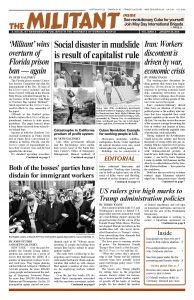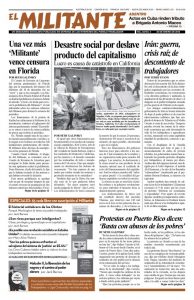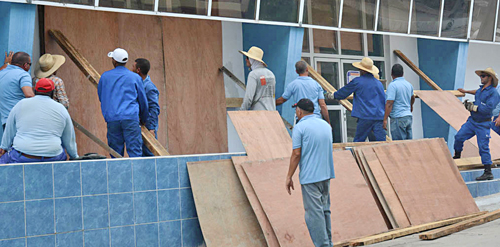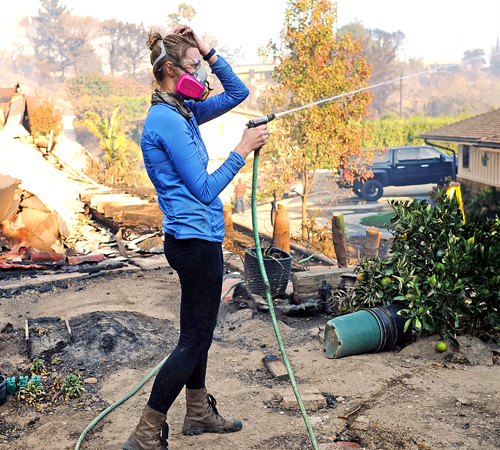Like other government officials and the big-business news media, Rob Lewin, head of the Santa Barbara County’s Office of Emergency Management, blamed residents of Montecito, California, themselves for the deaths and disaster visited on the town by widespread mudslides and flooding Jan. 9. He said they simply didn’t heed evacuation orders given prior to the rain and mudslides, claiming there was “no way anybody who was watching the news or paying attention didn’t get it.”
He also said the rain was beyond anything they could have handled. “It was a 200-year storm, and we had half an inch of rain in five minutes,” Lewin told the media. The mudslides killed at least 20 people, destroyed 100 homes and shut down drinking water, electricity and natural gas in the region.
But government officials did little to warn the towns’ less than 9,000 residents, and nothing to organize to get them out of harm’s way. The deaths, destruction and social crisis are a man-made disaster, not a natural one — the direct result of the workings of capitalism. It’s “every man for himself” moral values, and the callousness of the capitalist government at every level.
The way the Cuban people and their revolutionary government mobilized to meet Hurricane Irma stands in sharp contrast.
The mudslides are a direct result of the Thomas Fire, which ravaged nearly 240,000 acres in the area in the first two weeks of December, and of the way the propertied rulers responded. The fire burned so destructively because years of drought were followed by a year of heavy rains that gave a spurt to combustible grasses, shrubs and trees, followed by another drought. Though officials knew this provided fuel for fires, they did nothing to thin it out.
Besides the damage and destruction, the fires also destroyed the top soil, creating prime ground for flooding and mudslides. This has happened many times in California. In the fall of 2003 after a fire ravaged the San Bernadino Mountains, mudflows killed 14 people. After the 2010 Station Fire, a mudslide damaged more than 40 homes in La Cañada Flintridge.
The increasing destruction from wildfires is not a “natural” disaster either. Seeking to maximize profits, real estate developers are building more homes near fire-prone vegetation and forests. Local governments fail to adopt policies that would prevent the accumulation of dry vegetation, creating the threat of large, uncontrollable fires.
Local officials issued mandatory evacuation orders Jan. 6 for some 7,000 people closest to areas burned by the Thomas Fire, and sheriff deputies the next night went door to door in that area. In addition, some 23,000 people were in “voluntary evacuation zones.”
Reports make it sound like the cops had talked to everyone. But Santa Barbara County officials admitted that only 1,200 residents in the mandatory zone had been contacted in person.
Government officials had a detailed map that showed in advance where they expected mudslides to hit the hardest. But many of those areas were labeled for “voluntary” evacuation. Voluntary warnings don’t actually advise residents to leave, but to be on “high alert, and ready to evacuate at a moment’s notice,” the Santa Barbara Independent explained.
Most importantly, no government authorities did anything to organize a collective evacuation, alternative housing, food and other necessities, or to mobilize crews to battle any flooding to come.
That’s the capitalist way. You’re on your own, and what you can do depends on how wealthy you are.
After the National Weather Service texted a flash-flood warning about 2:30 a.m., Jan. 9, county officials waited until 3:50 a.m. to send out a text-message warning to people in the area. By that time it was too late — a wall of mud moving at 20 mph or faster was already sweeping down the hillsides.
Montecito resident Cia Monroe told the Associated Press that her family had to evacuate three times during the wildfire and then was told they should evacuate a fourth time as the heavy rains hit.
“Where do you go when you’re a family of four and you don’t have a second home?” she asked, noting that a one-week stay in a hotel could cost them $3,000.
Now — after the deaths and destruction — people are being ordered to leave the area. “It’s martial law here, basically,” Sarah Ettman told AP.
Water and power have been turned off. When will water be restored? “We’re not days away, but certainly sometime before the next two months,” Nick Turner, general manager of the Montecito Water District, told the Los Angeles Times Jan. 15. Shades of Puerto Rico.
How Cuba responds to storms
It doesn’t have to be this way. The way the revolutionary government of Cuba responds to natural disasters is the exact opposite.
In a speech to Cuba’s National Assembly Dec. 21, President Raúl Castro recounted how the Cuban government worked with mass organizations, from unions to neighborhood committees, to evacuate nearly 1.8 million people prior to the arrival of Hurricane Irma, to get them out of harm’s way.
After the storm, brigades of electrical workers organized before the hurricane hit went into action. “In just 20 days the flow of electricity and water was re-established in the entire national territory,” Castro said. “Nobody was left on their own.”
It showed “the spirit of resistance and victory of our people, who confronted the event and the recovery period with organization, unity, discipline, and solidarity,” Castro said.
While rebuilding tens of thousands of homes still lies ahead, it’s being taken on in the same spirit.
Unlike in the United States, where the government’s priority is to protect the wealth of the capitalist class and dog-eat-dog prevails, in Cuba the government is run by working people and organizes to meet the challenges ahead.
A team of members of the Socialist Workers Party went door to door in Ventura, California, Jan. 13, an area hard hit by the December fire but spared the mudslides, so far. Militant subscriber Katherine Necessary said that during the Thomas Fire, “we were told it was up to us whether to evacuate or not.”
“There is no reason that people in Santa Barbara should have died,” she said, pointing to similar government inaction in the face of the mudslides.
Dennis Richter from Los Angeles contributed to this article.



